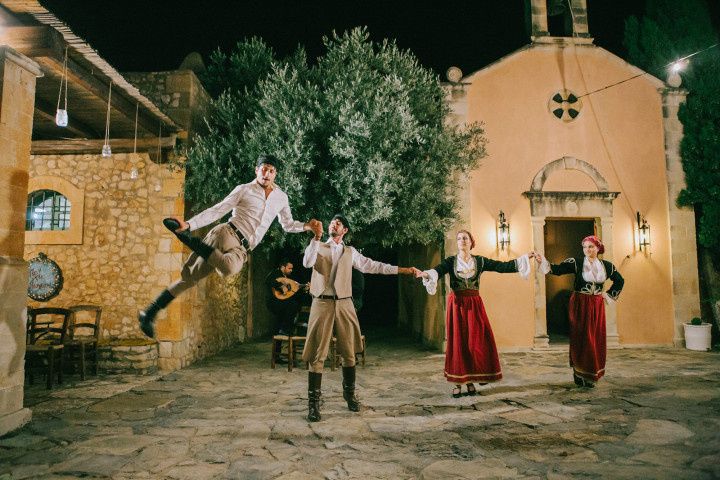The Ultimate Guide to Greek Wedding Dances
Rompi Rompi to Mavi Mavi, kick off your shoes and get ready to review classic Greek wedding dance moves.

Whether you’ve been to a Greek wedding or not, you’ve likely seen Greek dance either in movies, social media, or at your local Greek fest. But if you’re headed to a Greek wedding, it’s a great idea to learn more about the dances (and even take some lessons!) prior to the big day.
Dancing is a huge aspect of Greek culture, connecting a worldwide diaspora through something accessible to everyone—the language of movement. Greek dancing is so culturally ingrained that most social events and celebrations would be incomplete without it, and it makes up a huge part of traditional Greek weddings. In fact, its roots trace back all the way to ancient times, with evidence of the line dances still performed today documented in the Iliad (published in the 8th century B.C.). Through dance, Greeks are channeling kefi, the concept of uninhibited joy, exuberance, passion, and euphoria, fully letting go so you can be in the moment.
This guide will take you through some of the most popular traditional Greek dances, plus some of our favorite examples of each.
Kalamatianos & Syrtos
Most Greek events and weddings will typically start with the Kalamatianos or Syrtos, festive and joyous dances that trace all the way back to Ancient Greece. These are currently the most popular and widespread Greek dances in Greece and the Greek diaspora. Dancers hold hands in a semicircle, moving in a clockwise direction to a 12-step count. Though the steps are identical, Syrtos is slower and more steady with a 4/4 beat, while Kalamatianos is a bit more lively with its ⅞ beat—so get ready to burn off some calories from that wedding cake. Kalamatianos and Syrtos can be set to both traditional folk songs as well as modern pop music. Typically, the wedding reception kicks off with the bride, groom, and entire wedding party dancing to a Kalamatiano, so bridesmaids and groomsmen, be prepared!
Sirtaki
Perhaps the most world-renowned Greek dance is the Sirtaki—also known as Zorba’s dance. This dance was choreographed specifically for the 1964 movie, “Zorba the Greek,” but has since become a classic. The Sirtaki incorporates elements of various regional Greek dances into a line dance where dancers hold each other’s shoulders and drag their feet, hop, and leap to 4/4 meter that eventually builds in speed to 2/4. Even if you’ve never been to a Greek wedding before, you’ll probably recognize the song the minute it starts to play. This is one of the easiest Greek dances to learn, which is perfect for beginners!
Tsamiko
Slow things down a bit with the Tsamiko, a slower line dance set to a 12-step scheme that leaves room for improvisation. At the climax of most Tsamiko songs, there is a clarinet breakdown where the line leader (most often a man—but not always) can improvise—hopping, stomping, twirling, or performing acrobatic stunts like flips, handsprings, and pistol squats. Make sure to get a good stretch in beforehand! Tsamiko traces back to the Greek War of Independence, where rebel forces would perform the dance. That means there’s a rich tradition of this dance emphasizing solemn style and grace. Tsamiko is most popular in the Peloponnese region of Greece and Epirus.
Ikariotikos
Each of the renowned Greek islands has its own cultural identity, which means many have their own dances. One of the most popular nisiotiko (from the island) dances is Ikariotikos, which hails from the Aegian island of Ikaria. Dancers hold their arms in a basket weave position (crossing arms to reach each other’s shoulders) in this line dance as they hop and move their weight to different sides of their bodies. The Ikariotikos dance is typically accompanied by an iconic song with the same name.
Hasapiko & Hasaposerviko
Remember that wistful song from the opening sequence of My Big Fat Greek Wedding? That’s an example of Hasapiko, a Greek folk dance that originated in Asia Minor in the Middle Ages, where it was performed by butchers with swords. Nowadays, this dance has ditched the weapons, but it still includes some killer moves. Hasapiko and its faster version, Hasaposerviko, are still line dances performed by dancers holding shoulders and completing a series of leans, kicks, and steps.
Zeibekiko
Now, on to the solo dances. Zeibekiko is the embodiment of bravado and machismo—a freestyle solo dance typically (but not always) performed by men. During a Zeibekiko, a dancer will step, spin, hop, jump—and often take a shot—with their hands spread wide like a proud eagle circling the sky. Zeibekiko songs are a subset of the rebetika, a bluesy, urban style of music that originated with the displacement of Greek populations in Asia Minor. These songs grapple with some pretty heavy themes, like heartbreak, death, and/or despair. That’s why when one is dancing a Zeibekiko, it is absolutely imperative that they feel the music. They’re channeling deep emotions that make for a near-spiritual experience. Typically only one or a few dancers perform at once, and other guests will surround those dancers, take a knee, and clap to the rhythm to show support.
Tsifteteli
If Zeibekiko is for the guys, then Tsifteteli is for the ladies. A type of freestyle belly dance, Tsifteteli is performed solo by dancers swinging and rolling their hips while waving their arms and hands around. It’s very similar to Middle Eastern belly dance. Tsifteteli is definitely sexier than the other Greek dances, and dancing on tables is fair game at this point—some would even say encouraged. Like Zeibekiko, this dance is likely best saved for later in the evening, after some drinks have been had.





